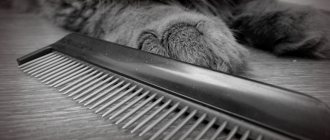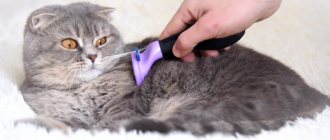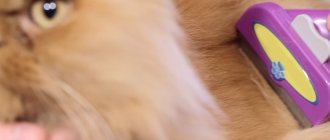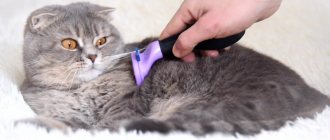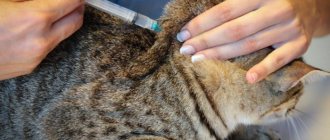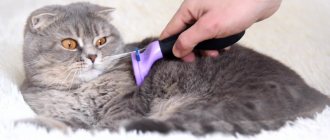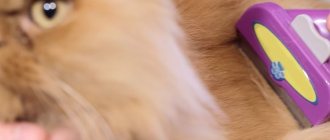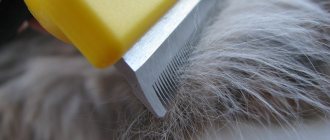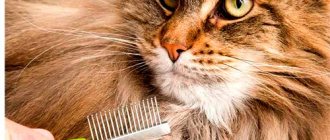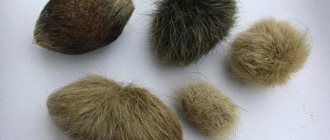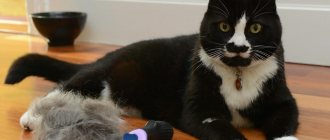What will you learn from the article?
- Why care for your cat's fur?
- How to comb a cat Tools for combing cats
- Massage tools
- Special tools
- Combing rules
Why do you need to care for cat fur, how to comb it, what grooming tools to use at home - look for answers to all these questions about caring for cat fur in our article.
Combing cat hair
During seasonal molting, cat hair scatters throughout the apartment. Therefore, combing cat hair is a necessary procedure. Care varies depending on density, length and breed. It is important to know what you can comb with and how often. In the article, we talked about why pets shed, what tool to choose, and how to accustom an adult to this procedure.
Combing wool
Combs for the British
Every loving animal owner thinks about which comb to choose for his British cat. On the shelves of pet stores there is an incredible variety of such items that can be selected according to the individual preferences of the owner of the furry animal, for every taste and budget. There are different types of combs:
Such a device can be made in the form of a mitten.
- with Teflon coating;
- comb rake;
- with stainless steel teeth;
- with rotating teeth;
- comb with multi-level teeth;
- brush-mitten.
The length of the brush teeth is selected depending on the length of the pet’s coat; it is very convenient that this information is indicated on the product packaging. The hair of the British is quite short, so that all of the above combs can be used; caring for the delicate fur of this type of breed can be replaced by regular wiping with a wet hand. As a result of this procedure, much more hair is removed than with brushes. The British fur coat is the main advantage of a cat, which is why care should be as thorough and effective as possible.
Furminator and its types
This is a very popular miracle tool for combing the coat of a British cat, and the process does not cause discomfort to the animal, and more often, even the opposite. There are two types of furminators - classic type and deluxe. The only difference between these varieties is the presence of a FURejector button in the deluxe line for automatically removing hair from the comb. Each of them is designed separately for each type of cat - short-haired and long-haired.
Before brushing your cat with a furminator, you must comply with the following conditions:
- It is advisable to bathe the animal and dry the fur before the procedure.
- Do not use if there are lesions or wounds on the skin.
- Before the procedure, comb with a regular brush.
- Cut off all tangles using scissors.
- Start combing slowly according to hair growth. Particularly carefully comb the area of the abdomen and anus.
Return to contents
Why do cats shed?
Shedding is a natural physiological process. Twice a year, animals begin to lose hair more often than usual: in spring and at the end of autumn. A decrease in temperature before the onset of cold weather turns on the mechanism in cats that is responsible for changing their fur. In animals it becomes denser to protect them from frost in winter. In spring, “winter” fur is no longer needed, so cats shed.
The cat is shedding
Don't worry about seasonal shedding. The cat's body thus reacts to environmental changes.
But if you notice that your cat sheds more than twice a year, there may be a health problem.
- Poor nutrition
Fried, fatty, spicy and sweet foods negatively affect the quality of wool. The cat's fur stops shining, becomes dull and begins to fall out. Lack or excess of nutrients also affects the intensity of shedding. One of the reasons may also be the pet’s compatibility with the type of feeding. Perhaps dry food or improper nutrition is not suitable for the cat.
Poor nutrition
- Improper grooming
Shedding may begin due to inappropriate grooming products. It is worth asking your veterinarian which shampoos and combing brushes you need to purchase.
Improper grooming
- Frequent bathing
Cats are naturally clean. They practically do not need bathing. It is recommended to wash approximately 2-3 times a year. Housewives often go overboard with the frequency of bath procedures. As a result, the hair becomes degreased, becomes brittle and falls out.
Frequent bathing
- Diseases
Hair loss can be caused by diseases of the internal organs. You need to consult a veterinarian and get tested.
- Allergy
Along with molting, symptoms such as rash, ulcer, and crust formation appear. Allergies may be to food, litter, perfumes, or tobacco smoke.
- Stress
A pet may experience stress when the owner pays little attention to it, spends a lot of time alone, or is jealous of other pets or family members. If your cat has no problems eating or grooming, she is probably stressed.
Why care for your cat's fur?
Regular brushing sessions clean the animal's fur of dirt and dander, remove dead hair, prevent the fibers from getting tangled and reduce the number of hairballs in the cat's stomach.
By combing the animal, you give it a massage. This improves blood circulation in the upper layers of the skin, which leads to improved coat quality. During the hot season, brushing helps prevent heatstroke.
Grooming helps keep your home clean while your pet is shedding. If you don't brush out a shedding cat, dead hairs will fly around the apartment, accumulating on the floor, carpeting, furniture and your clothes.
Do I need to brush my cat?
The cat needs to be combed. Otherwise her fur will be everywhere. Brushing will not only help keep your home clean, but also remove dried dirt, remove dead hair from the surface, unravel tangles and give your pet a well-groomed appearance.
Cats need to be combed
In addition, combing cat hair is a pleasant procedure. It resembles a massage that gives cats pleasure.
Furminator and cat combing: reviews
Those cat owners who have already tried the Furminator to treat their pet's fur are satisfied with their purchase. Although the vast majority of reviews include dissatisfaction with the cost of the tool.
4 years have passed since the purchase, and I have never regretted the money spent. This gadget is still worth the money. You just need to scratch your cats more often, and the fur will no longer bother you.
Guzik-Arbuzik, forum user
https://irecommend.ru/content/shok-sensatsiya-koshatniki-menya-poimut-furminator-kak-sredstvo-izbavleniya-ot-klokov-sherst
More economical cat breeders purchase more budget options for trimmers, but the question of the cost of the product remains.
The first tests showed that the Trixie trimmer is not very effective for our cats, but it works. The advertisement is beautiful, the price is high, there is some sense, but not at this price. Not to say that the tool is bad, but it doesn’t make the task much easier. The undercoat rips, but everything flies around in clouds, which is a little annoying.
Mikhail, forum user
https://otzovik.com/review_750764.html
Other cat owners purchase a more expensive device. And, if you compare the device with a classic powder brush, of course, the Furminator wins.
When the Foolee trimmer was still new, it was full of slogans like “Lifetime warranty, money back,” they promised super blades and construction, and even offered a free replacement in case of breakdown. And after a couple of years of use, I can say with confidence: the Furminator is excellent, to this day it’s like new.
Tired, forum visitor
https://irecommend.ru/content/sluzhit-bolee-2-let-idealno-podkhodit-koshkam-i-sobakam-vychesyvaet-dazhe-zhestkuyu-sherst
And there are those who tried the budget version of the furminator. Most reviews are positive.
When I first ran the HelloPet trimmer over Laura's fur from head to tail, I was very surprised. I never expected such a result. There was a huge amount of unnecessary hair left on the furminator blade, the existence of which I did not even know existed.
EkLip, forum user
https://otzovik.com/review_5742181.html
Video: slicker vs furminator
The Furminator is a comb-trimmer for combing the undercoat of pets. In addition to the original Furminator trimmer, Russian cat breeders can purchase devices from other manufacturers (Trixie, Foolee, HelloPet and others). The trimmer significantly speeds up the process of combing out dead hairs, but does not damage healthy guard hairs. The operating principle of all furminators is approximately the same. There are also more conservative tools: combs, brushes, combs, etc. But people who bought a trimmer are satisfied with the time savings. Although there are also negative reviews associated with the high cost of the device.
Contraindications
The combing procedure is individual for each pet and has contraindications:
- Breeds such as Cornish and Devon Rex, Turkish Angora, Burmese and Singapore cats, and Orientals require special care. These breeds have a special type of coat, some do not have an undercoat, so it is not recommended to use a furminator for combing.
- You should not use a slicker if your cat has mats.
- The Furminator and slicker should not be used daily.
- You should not comb your cat immediately after bathing when the fur is wet.
- Do not comb an animal if there is irritation or redness on the body.
Reasons for the formation of mats in cats
A mat is a dense lump of matted wool. Long-haired cats are more likely to develop mats. Mats are formed from undercoat hairs (thin, short, almost “downy” hairs) that were not removed in time.
Persian cats are prone to matting
If such lumps have formed in a short-haired cat, then there is a possibility that the cat is seriously ill. In this case, you need to urgently contact a veterinarian. But in cats with long hair, tangles can appear for several reasons:
- oral diseases;
- dermatological problems;
- the appearance of skin parasites;
- wool contamination;
- incorrect selection of food products;
- improper care, etc.
Active young cats can look after themselves. If tangles have formed, then the cat cannot cope on its own. Most often this happens because the animal is suffering (for example, if the cat has an oral or skin disease). After all, licking fur on flaky and cracking skin can be painful. In cases where the pet has skin parasites (lice, fleas, lice eaters, etc.), the animal has to lick itself more often. Wool that does not have time to dry falls into clumps. In addition, the reason for the formation of tangles may lie in the wool itself. So it may be contaminated with a substance that is difficult to wash off.
Imagine a situation where chewing gum or plasticine got into your hair. The hair gets tangled, stuck together, and trying to clean out the Velcro is very painful. In cats, such “sticking” can occur due to oil or glue getting into the fur, for example.
In addition, the coat can become brittle and brittle due to poor nutrition (for example, lack of vitamins). This is how the split ends of the undercoat become tangled and turn into tangles. And finally, the main reason for the formation of lumps is improper care of the cat’s hair. Cats should not be washed with shampoos intended for humans. Sometimes after washing a pet (even with cat shampoo), the owner rushes to dry the cat as quickly as possible. Improper drying of a cat after bathing also leads to matting of lint. The wool can be blotted with a soft towel rather than rubbed.
Selecting a brush: rules
When choosing a brush for combing, it is important to take into account the characteristics of the coat, namely:
- Her condition
- Density and length
- Purpose of the procedure
This natural bristle brush is suitable for all breeds. The mitten is often used for massage and untangling tangles. The comb is suitable for daily combing of short-haired breeds, as well as getting rid of fleas. A slicker is recommended for getting rid of dead particles.
There is a large selection of combs; you need to buy the one that suits your pet’s coat type.
How to comb out correctly
First you need to purchase a tool that suits your cat's fur type.
How to properly comb a cat?
How to comb the hair of short-haired cats? A furminator, a comb, a mitten, and a double-sided brush are suitable for such individuals. It is recommended to dampen the wool a little so that the fluff does not fly around the apartment. You need to comb along the hair growth. After combing, you need to put on a special mitten and give your pet a massage. This step will remove dead hairs.
For long-haired breeds, brushes with stiff bristles are suitable. Furry animals often develop tangles, so before combing, you need to carry out a bath procedure. It is worth bathing the cat with special shampoo and conditioner that will soften the hair. After washing, remove tangles and then begin combing.
Often cats do not like to be brushed, so you need to calm your pet before the procedure. After a successful attempt to bring the cat into a well-groomed appearance, treat it with a delicacy.
Review of popular models
In addition to the original Furminator, there are also trimmers from other manufacturers. There are many of them, but let's look at a few of them. One of the most popular brands in Russia is Trixie Heimtierbedarf GmbH & Co KG (Trixie). This German company has been producing pet products for over 40 years. The manufacturer offers its trimmers as a universal anti-shedding product. The operating principle of this device is the same as that of trimmers of other brands. The developers named the following properties as advantages:
- the device helps to comb and cut tangles;
- the nozzle can be easily changed using a built-in mechanism;
- stainless steel blade;
- plastic handle with anti-slip rubber coating.
Trixie is about 2 times cheaper than Furminator. This trimmer has a button to change the attachment. And although the manufacturer claims that the blades are sharp enough and made of stainless steel, they still have to be replaced. Moreover, the instructions for use do not mention the shelf life of the blades. In practice, a replacement nozzle is installed after about a year. The cat owner should purchase a replacement attachment as the blades become dull. The price of a new comb with blades is not much different from the cost of the trimmer itself.
The Trixie trimmer has a modest design (this is due to the fact that trimmers are not the main product of this manufacturer)
Another alternative to the original furminator is the Foolee trimmer. The French manufacturer boasts a wide range of combs, brushes and trimmers for cats. The main advantages of furminators of this brand are the following qualities:
- the nozzle can be changed as the blades become dull;
- wool is removed from the blades by pressing an additional button;
- any model of the Foolee trimmer is equipped with a handle of an unusual, comfortable shape;
- All Foolee devices have a non-standard design (unusual shape, bright color).
And although the manufacturer pays more attention to the appearance of the device than to other parameters, the price of the French Furminator is one of the highest. Foolee offers trimmers and other grooming tools for pets of all sizes. You can purchase a trimmer for cats with different hair lengths. The device is beautiful and safe, but subsequent treatment of the wool with a slicker is necessary.
All Foolee trimmers have a striking design
Another brand, HelloPet, is a product of a Taiwanese manufacturer (founded in 1969). The official distributor in Russia is. Buyers are offered devices in an affordable price range. The simple design does not detract from the functionality of the devices. In addition to furminators of different sizes, HelloPet produces rake furminators. By the way, the Taiwanese manufacturer clearly distinguishes between the concepts of “trimmer” (a machine for cutting hair) and “furminator” (a comb with a blade), and uses only steel and plastic as materials. There are several types of HelloPet comb trimmers:
- small furminator - 43 teeth;
- medium furminator - 65 teeth;
- large furminator - 79 teeth;
- super-large furminator - 97 teeth.
The greater the number of teeth, the wider the surface area being machined. Typically, for medium-sized domestic cats (up to 5 kg), the smallest Furminator is chosen.
A distinctive feature of HelloPet trimmers is the presence of many small nuances in each model. For example, a furminator rake is equipped with teeth that can rotate. This device is convenient to use for caring for unruly animals. Large furminators (79 teeth) are equipped with a button for removing combed wool.
All Hellopet furminators have a handle with a pattern in the form of paw prints (this is the official logo of the manufacturer)
After reading reviews and studying different types of furminators, I decided to buy the most budget-friendly device, although my cat does not shed much (a massage mitten is enough for us). I went to two pet stores. On display there are original devices and cheaper options from Chinese manufacturers. I didn’t find HelloPet in any of these stores. Perhaps the brand is not one of the well-promoted brands. And, most likely, the affordable price is explained precisely by this, and not by low quality.
Treatment frequency
The frequency of the procedure is determined depending on the breed. If the animal has short hair, it is enough to brush it once a week. Long-haired cats require more frequent grooming. They need to be combed daily with special tools for several minutes.
During seasonal molting, the frequency of the procedure increases. Fluffy cats need to be brushed 2-3 times a week, and short-haired cats - 1-2 times.
Combing frequency
How to comb a cat's fur at home
A caring owner knows how to brush a cat well. It is advisable to accustom your kitten to hygiene procedures from a very early age. Then he will not be afraid of brushing and, perhaps, will even be able to enjoy it. It’s also not too late to teach adult fluffies to be brushed, but they will need more time to get used to it. If the furry beauty enjoys being combed, this procedure will not cause any inconvenience to anyone.
The Scottish breed is the most shedding
If any irritation appears on the skin, it is better to postpone combing until it heals. You need to start treating dermatitis, allergies, and fungal diseases as quickly as possible. Under no circumstances should you touch the wound with a comb.
The hand should move smoothly and gently. Do not press the comb too hard or make sudden movements, as this can damage the hairs and scare the cat.
How to comb a cat, step by step instructions:
- You need to stroke the cat with a mitten or run a wide-toothed comb through the fur.
- You need to start combing with a mitten, then use a furminator and a slicker, then different combs. It is advisable to complete the procedure with a massage comb and a brush with natural bristles.
- First, comb along the hair growth, and then against it. This effectively cleans the coat.
- Within a few minutes you need to comb the back, sides and tummy.
- It is worth paying a lot of attention to hard-to-reach areas. Take turns combing the “pants” near each paw, then the back of the head and withers.
- The smallest combs will be needed for combing the neck and the area around the ears.
- Small tangles need to be combed separately. They are moistened with spray and then smoothed using a comb. Large mats should be cut off by professional groomers with a special tool. It's better not to do this on your own.
- After combing, you should moisten your hand with water and stroke the cat with it.
The entire procedure will take no more than 5–10 minutes, but it will bring a lot of benefits to the furry pet and its owners.
Important! If the kitten does not like to be brushed and begins to resist, you need to distract him with his favorite toy or treat. This also helps adult animals. Each cat has its own personality, so you need to be patient with them.
Even if the owner does not yet know how to brush a cat, he will quickly learn it. This requires a little patience. It is not at all necessary to contact a groomer; it is enough to know how to brush a cat at home and how it is done.
Special shampoos for long or short hair will help your furry pet be beautiful and make it easier to care for. It is very important to periodically treat your cat with green grass or sprouted oats. You can buy it at a pet store or grow it at home in a special box. Grass and oats are a natural gastric cleanser. In addition, cats love grass very much for its pleasant taste and aroma.
Brushing cats: features by hair type
The specifics of the procedure vary depending on the cat's coat type.
The following types are distinguished:
- Long
- Semi-long
- Short with undercoat
- Short without undercoat
Breeds with a long type include Maine Coon, Himalayan, Persian, Burmese Siberian individuals. They are combed 1-2 times a day for several minutes. First you need to use a comb with wide teeth, and then with frequent ones, so as not to damage the skin. Before combing, you should bathe or moisten the hair with warm water.
Combing long-haired breeds
Breeds with semi-long coats: Bengal, Balinese, Ragdoll, Korat, Russian Blue. The frequency of combing is 2-3 times a week with a wide-toothed comb, then with a fine-toothed comb.
Shorthair cats with undercoat: Abyssinian, Anatolian, American Shorthair, Oriental, Ocicat. They should be combed 1-2 times a week, first with a wide-toothed comb, and then with a fine-toothed or metal comb.
Canadian, Don Sphynx, Peterbald, Cornish and Devon Rex have no undercoat and rarely shed. They should be brushed once a week with a natural bristle brush.
Mitten: the easiest to use
If your pet doesn't like combs and slickers, try using another tool popular among cat owners - a rubber mitten.
We invite you to familiarize yourself with: American Shorthair cat (45 photos): an attractive breed with a history
Short or long teeth, located at different frequencies on the surface of the mitten, perfectly massage the skin of the animal. Thanks to this, blood circulation improves, the hair follicles are strengthened, and the coat becomes healthy and shiny. Cats love this massage very much. It can be carried out both on dry wool and during water procedures.
How to train an adult cat to brush
Combing is an important procedure. During seasonal molting, your pet's hair begins to fall out profusely. While washing, they may swallow large hairballs, which causes digestive problems. Combing allows you to get rid of dead particles, excess hairs and lumps.
If your pet loves this treatment, you're in luck.
Animals often do not like to be brushed. The cat can escape from the hands, accidentally scratch or bite the owner, so you need to get used to the comb. It is easier to train a small cat, but older cats take a long time to adapt, so you should introduce a cat to a hairbrush gradually.
How to choose a scratcher or comb for a cat
When you come to the store and choose a comb or scratcher for your pet, take into account the length of the cat’s fur and the type of undercoat: long hair is difficult to comb out with a short-toothed comb, and short teeth on the tool are not suitable for thick undercoat. Also, using the comb should be convenient for the owner, and the cat should experience positive emotions. Pay attention to the following nuances:
- If you notice that your pet regularly avoids brushing or breaks out, you may need to choose a different tool.
- When choosing a brush, you should focus only on the cat’s preferences. If it does not suit her, the animal will simply ignore the device.
- In low-quality combs, the teeth can become electrified and give the cat an electric shock. This will scare away the cat, and then it will take a long time to persuade it to undergo this procedure. Therefore, when purchasing, it is better not to save money, but to immediately choose a quality tool.
- The teeth should be rounded at the ends so as not to injure your pet’s delicate skin.
- The width of the working surface of the device must correspond to the size of the animal: the smaller the cat, the smaller the tool.
